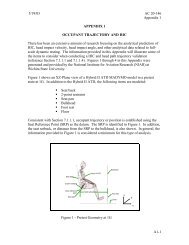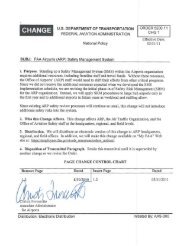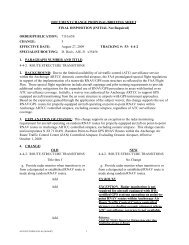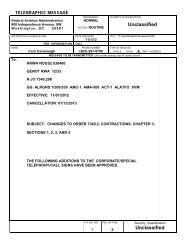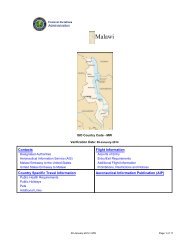2009 SMS Pilot Project (SMSPP) Analysis - FAA
2009 SMS Pilot Project (SMSPP) Analysis - FAA
2009 SMS Pilot Project (SMSPP) Analysis - FAA
You also want an ePaper? Increase the reach of your titles
YUMPU automatically turns print PDFs into web optimized ePapers that Google loves.
• Developing and maintaining the <strong>Pilot</strong> <strong>Project</strong> Tracking Matrix<br />
• Developing, maintaining, and using the Gap <strong>Analysis</strong> and Implementation Plan tools<br />
• Use of outside consultants; e.g., IBM, Booz Allen Hamilton, MITRE, Volpe Center,<br />
Embry-Riddle Aeronautical University, and St. Louis University<br />
• Cross-utilization of resources across the service and geographical locations<br />
Industry Best Practices<br />
• Using Transport Airplane Risk Assessment Methodology handbook (TARAM) as a<br />
reference for Safety Risk Management. It outlines a process for calculating risk<br />
associated with continued operational safety (COS) issues in the transport-airplane fleet.<br />
It explains how to use such risk-analysis calculations when making determinations of<br />
unsafe conditions, as well as selecting and implementing corrective actions.<br />
• Utilizing Small Airplane Risk <strong>Analysis</strong> handbook (SARA). The handbook process<br />
provides Aviation Safety Engineers (ASEs) with guidance for estimating the risk<br />
associated with airworthiness concerns. SARA also provides guidance on how ASEs can<br />
use estimated risk as a consideration in making unsafe condition determinations and in<br />
evaluating corrective actions.<br />
• Rotor Manufacturing <strong>Project</strong> Report (RoMan) DOT/<strong>FAA</strong>/AR-06/3. This report provides<br />
guidelines useful to ensure the manufacturing process minimizes the likelihood of<br />
manufacturing induced anomalies reaching service usage.<br />
• When delivering <strong>SMS</strong> briefing/training materials and discussing the DGA internally, it<br />
was better to group employees by experience level and not by discipline. The lessexperienced<br />
personnel were less likely to ask questions or speak out about potential<br />
hazards.<br />
• Reducing the complexity of the <strong>SMS</strong> processes makes it more accommodating for<br />
companies with multiple business units and multiple locations.<br />
• Having a senior executive oversee the implementation of the <strong>SMS</strong> ensures that the<br />
implementation process should not go through significant changes later due to<br />
management concerns.<br />
39



